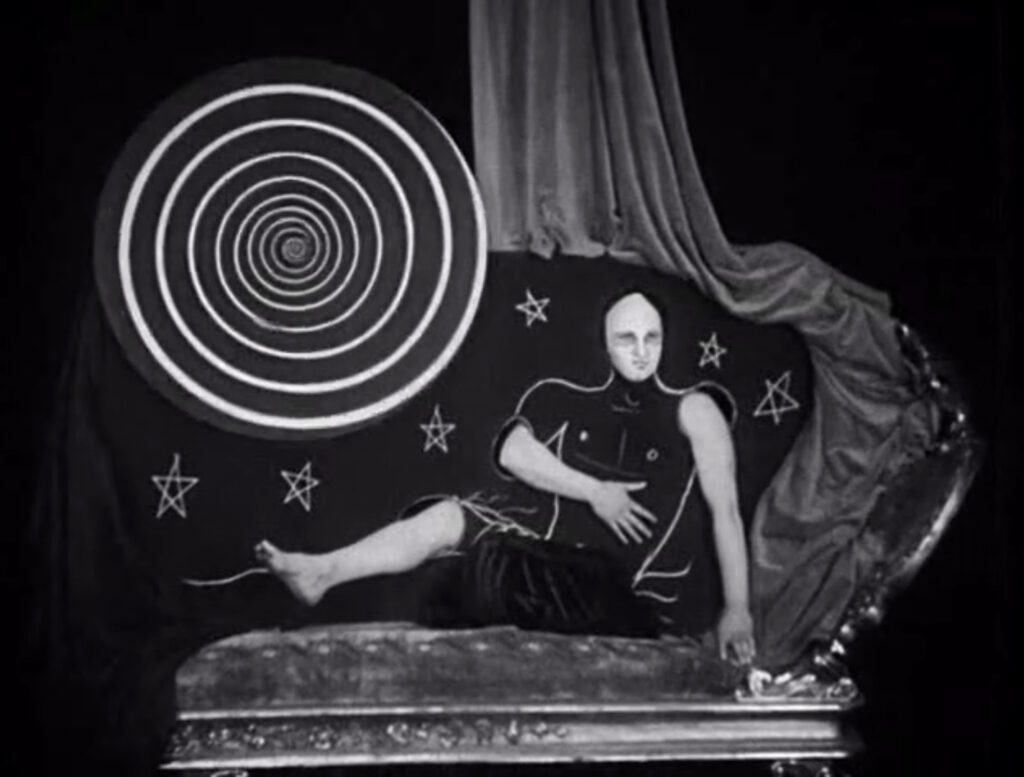
The Blood of a Poet
1932, directed by Jean Cocteau
One day, while working on an abstract portrait, a young artist hears an unexpected visitor at his door, presumptuously testing the latch before knocking. At first the artist ignores the sounds, imagining instead the Battle of Fontenoy raging outside, the knocks transformed into cannon fire. Like his friend behind the door he wears a wig in the style of the 1790s, as if he fancies himself a revolutionary. As an artist he’s something of a poseur, and he’s sealed himself up in his modest studio – but now, owing to this unwelcome intrusion from the outside world, something remarkable happens. In one of those accidents that sometimes befalls an artist, his painting comes to life and begins speaking. Against his solipsistic nature, thoughts of the outer world have sparked an unfamiliar inspiration.
At first he’s embarrassed. If he answers the door he can’t let his visitor see what he’s done, so he quickly erases his work, smearing the canvas. Somehow, though, that effort is not enough. The inspiration has changed him, and his friend recognizes the difference. Being of similar bohemian spirit, his friend withdraws in disgust, leaving the artist alone. For a moment the artist shrugs off the incident. He hangs up his revolutionary wig and washes his hands, as if to purge the sin of creativity that has made him an outcast, but to his horror he finds the stigma fixed to his right hand. He tries in vain to shake it off. Finally he wipes his hand on an unfinished female statue, and the mark comes off… but now the statue comes to life as the painting had.
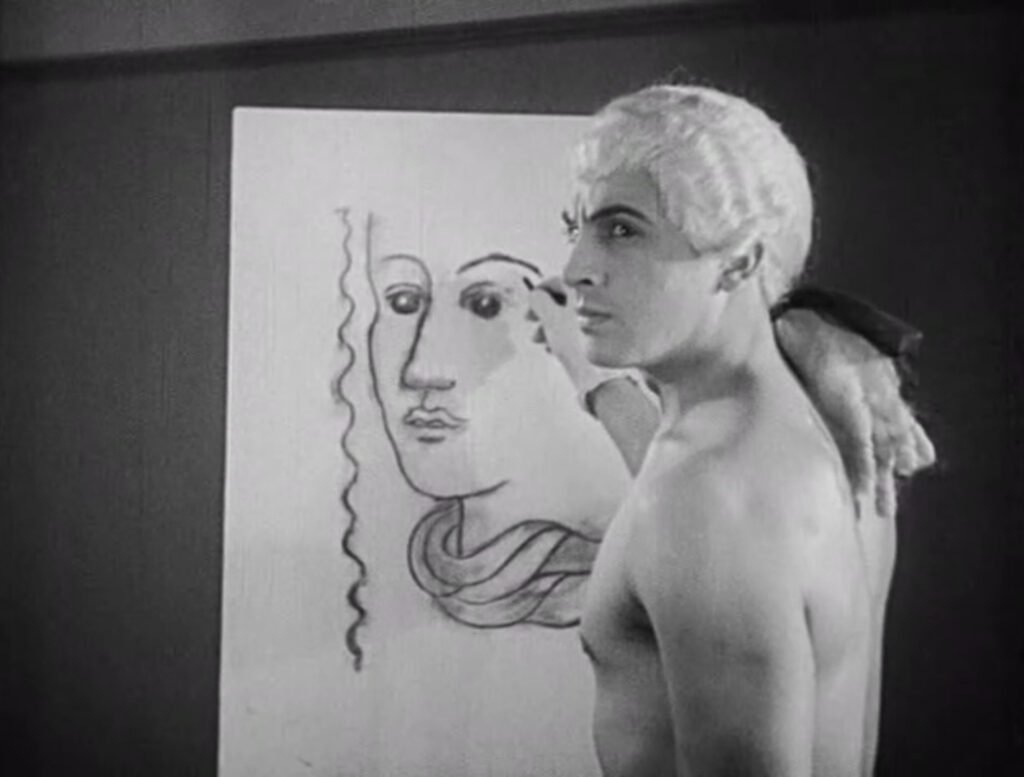
Unaccustomed to seeing any kind of independent life in his works, the artist is taken aback. When the statue commands him to look deeper inside himself, to “go into the mirror”, he obeys. He had always paid lip service to introspection (“You wrote that one could go into mirrors and you didn’t believe it”), but in this situation he’s forced to confront who he is.
His inner journey is most unpleasant. He finds himself in a hotel corridor, peeking into the keyholes of successive rooms as if surveying his own compartmentalized mind. In his disorientation gravity behaves oddly, making it hard to move from room to room. In one chamber he finds compulsive violence, an execution repeated ad infinitum. In the next, a shadow of two hands obsessively manipulates long needles. In the following room, behind a sign for “Flying Lessons” is an abusive scene from childhood. In the last room a hermaphrodite sticks one body part after another through holes in a couch, as if to remind him of his own sexual secrets. Having seen the contents of his mind so bluntly displayed, he shoots himself in the head… but he’s still in a dream state, and he soon emerges from the mirror to face his artwork again.
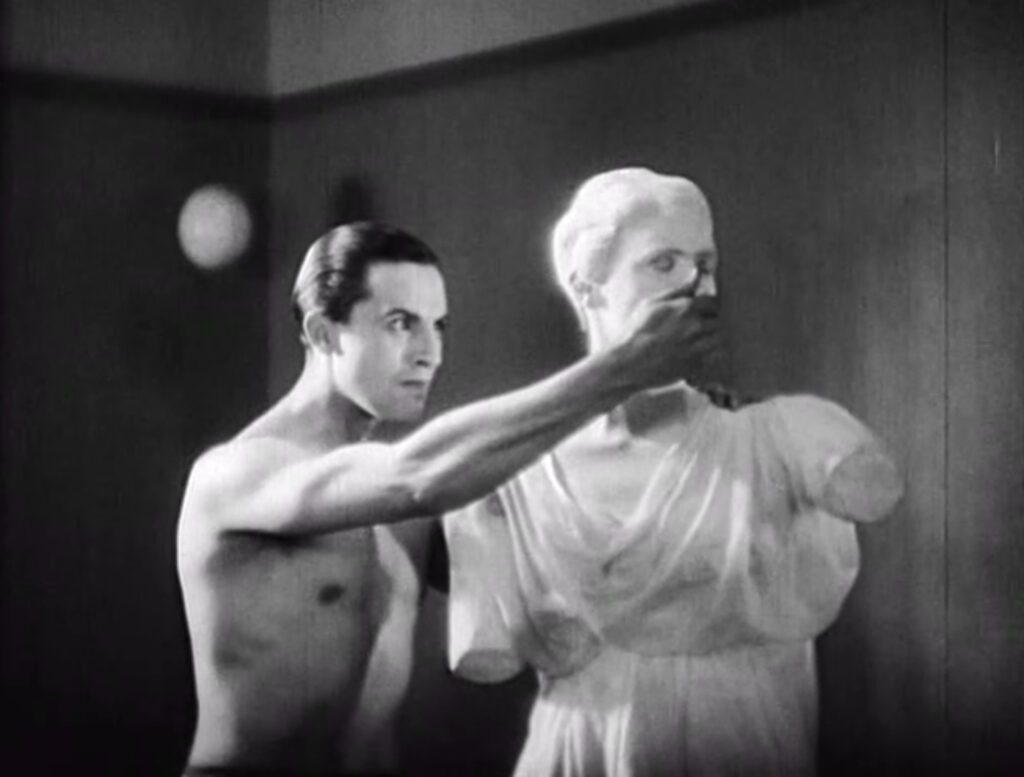
Now he’s furious at the statue. Ever since he began painting and sculpting, he had had some idea of creating art that expressed his inner being, or that diverted vision from its usual channels – but now that he’s done exactly those things, he doesn’t like the results. He smashes the statue, striking first at the face where its life manifested, but once again his act of destruction is misdirected. Like the painting on his easel before, this statue was only a symptom of a larger change in himself. He now turns into a statue, taking the place of his destroyed artwork.
The setting shifts outdoors from the artist’s studio to a snowy street. Schoolboys fight with snowballs, and a bully named Dargelos knocks another boy down with a loaded snowball. The scene comes straight out of Cocteau’s novel Les enfants terribles (written three years before this film, long before Jean-Pierre Melville’s 1950 adaptation). At this point everything should start to fall into place – the director is reflecting on his own experience as an artist. His stand-in, the young painter, is stereotypical enough to stand for artists broadly, and the statue with missing arms is a semblance of the Venus de Milo, a shorthand for artworks in general. In an earlier intertitle, before the artist wiped his “wound” on the statue, Cocteau had told us he was “caught in a trap by my own film,” and the following shot had shown a plaster likeness of Cocteau himself opening his eyes to stare at the speaking hand. The inserted snowball fight from Les enfants terribles roots the film in Cocteau’s own life as an artist. The schoolboys soon become supporting characters as the young artist and his living statue pop into the scene, playing cards at opposite ends of a table.
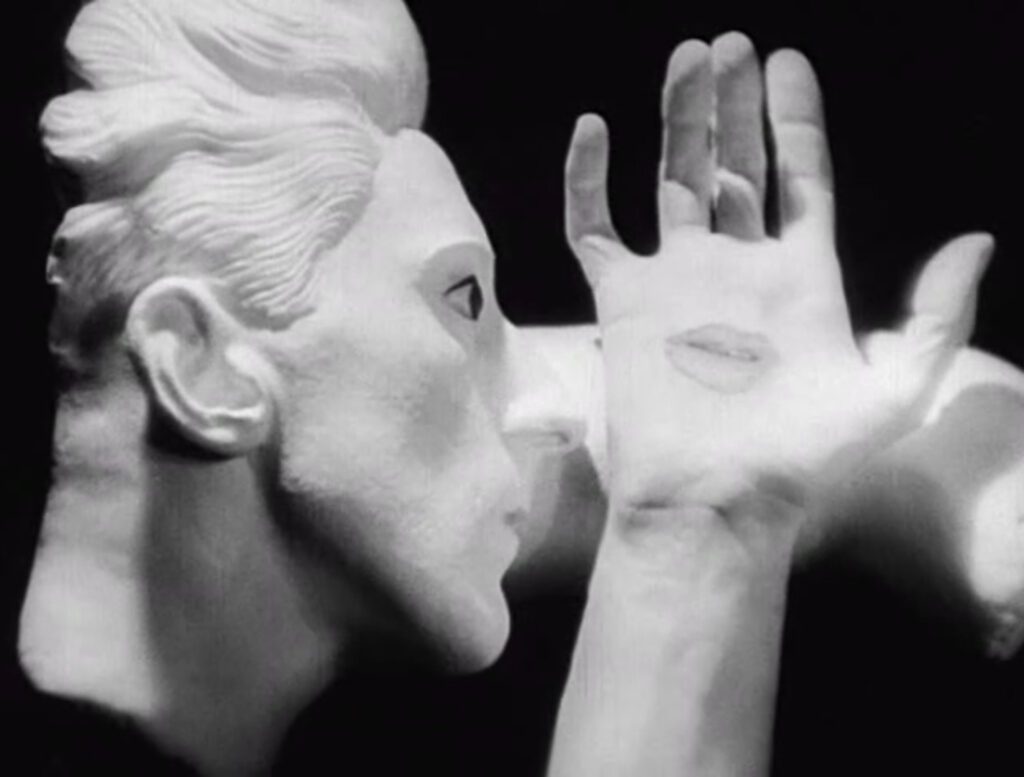
A text in the preface had defined the poet’s role (“poet” being another shorthand for “artist”) as composing “a realistic documentary of unreal events.” This phrasing is wonderfully ambiguous. Is The Blood of a Poet a nonsensical whimsy without antecedents in reality, or is it a series of “unreal events” anchored in reality? If we wish to take Cocteau’s film seriously, then the insertion of his autobiographical reality points to the latter. In contrast to the young artist’s revolutionary pretensions, The Blood of a Poet dispels romantic notions of creativity. When the painter first shoots himself, and shortly afterward when he turns into a statue, a disembodied voice urges him on: “Glory forever!” The film does everything it can to make the idea of an artist’s glory sound ironic.
Far from being the hero he imagines himself, the artist becomes a tragic figure, humbled by his own creation. The title and preface describe creation as a sacrifice, a gift of blood and tears. On the snowy street the artist competes with his statue before a self-absorbed and insensitive audience in a pair of opera boxes. He tries to cheat but loses badly, thwarted by his own character’s guardian angel who removes the stolen ace of hearts from his hand. Even when the artist tries to justify himself with a sign of love – the single heart on the card – his wish is forbidden to him. Having given life to the statue, he’s no longer needed. His blood drains from a star-shaped wound, echoing the tattoo beside the artist’s scar when he was first introduced. The star which had once been a vain heroic symbol is now another token of tragic irony. His first suicide was merely a dream; his second is a metaphor for the necessary effacement of the artist.
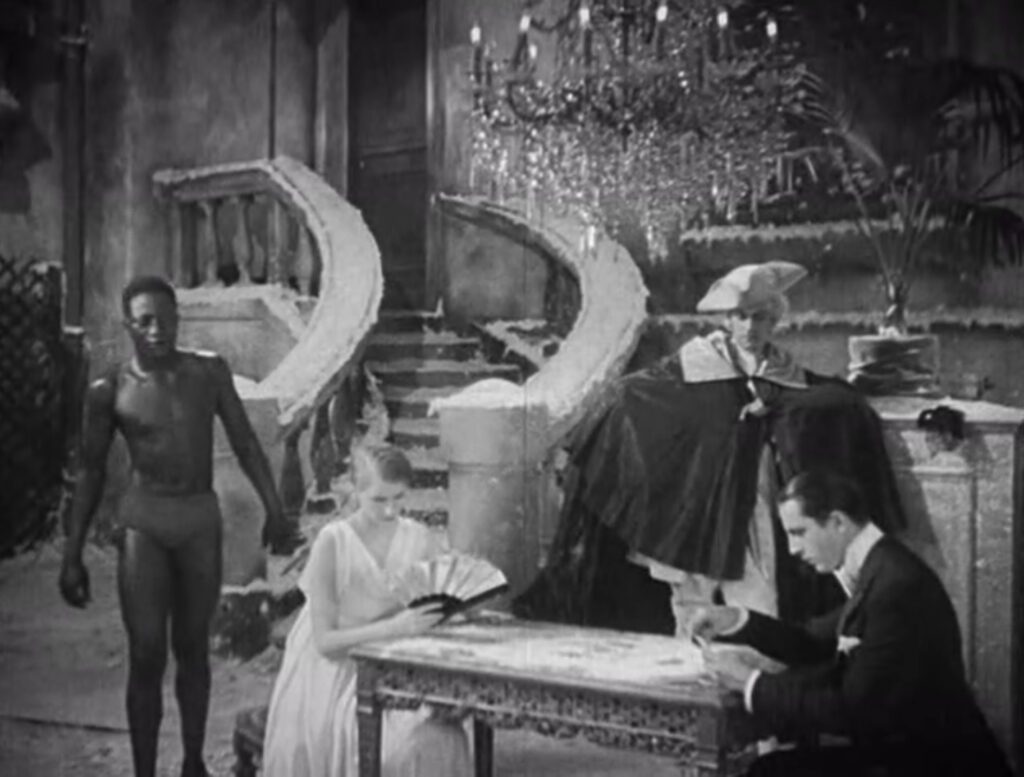
If only the statue had gone on to a glorious destiny, then something might remain of the artist’s romantic dreams – but instead she walks off into the darkness, into oblivion, accompanied by a bull whose horns become Orpheus’s lyre and whose patchwork hide is transformed into a globe. The statue enters the underworld, dying as the artist had, and as everything else in the world (the globe) must also die. Bracketing the film is footage of a falling smokestack, an image of death, entropy, and a deflated phallus all at once, putting the artist’s story into context. To create art is to struggle hopelessly but courageously against mortality. As the statue lies in darkness at the end, a voice-over comments: “The mortal tedium of immortality.” Cocteau will pronounce a similar paradox 18 years later near the end of Orphée when he says “The death of a poet requires a sacrifice to render him immortal,” again speaking of death and immortality as if they co-exist in the same subject.
As Cocteau clarifies in Orphée, his idea of immortality is not literal in the sense of infinite forward time. The Blood of a Poet acknowledges all too clearly that the artist and the artwork exist within the limits of the universe. What’s important rather is to inject the artwork with life – to connect it to the substance of living experience so that it represents, renews, and carries on something of sentient life. The alternative is to create stillborn works devoid of vitality, devoid of humanity, that represent a delusion or that represent nothing relevant to life.
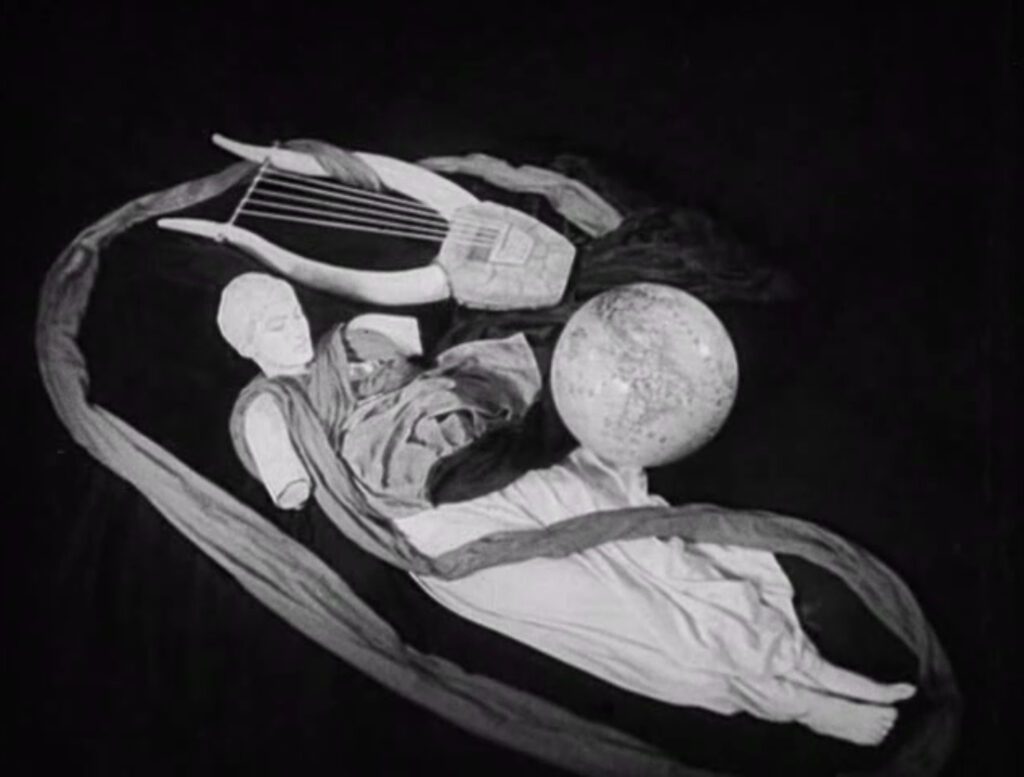
Behind this argument about art, The Blood of a Poet is fundamentally a cry against vanity. The youthful vanity of the would-be revolutionary artist, in his wig and his pants rolled up to resemble culottes, is more than matched by the indifferent vanity of his audience in the two opera boxes above the snowy street. When the artist shoots himself at the card table, the spectators clap enthusiastically; one of them applies make-up, and they chatter smugly, interested only in themselves and in whatever titillation the drama below stirs in them. An audience with a love of life would at least feel some sympathy for the character – even a fictional being – if the artwork is in some measure a receptacle of life.
CONNECTIONS:
Vampyr – Metaphor of blood for an artist’s sacrifice in connecting art to life
Orphée – Artist’s journey away from an inert kind of art; line near the end about death and immortality
Les enfants terribles – Snowball fight and Dargelos’ loaded snowball; allusions to Greek drama
Pickpocket – Protagonist’s journey out of a hermetic existence where doors represent a barrier to the outside world
David and Lisa – Statues associated with immortality; critique of society’s overly precious concept of art
Pan’s Labyrinth – Paradoxical idea that immortality requires a sacrifice of life